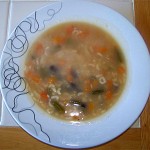 You’re probably thinking I’m pretty full of myself, making a claim like that. Well sure, it’s probably not for everyone, but if vegetable soup is your thing, you should try it my way at least once. And yes, that is alphabet pasta in my soup. I have a three year old.
You’re probably thinking I’m pretty full of myself, making a claim like that. Well sure, it’s probably not for everyone, but if vegetable soup is your thing, you should try it my way at least once. And yes, that is alphabet pasta in my soup. I have a three year old.
Do I really need to extol the virtues of homemade soup chock-full of veggie goodness? Probably not, but I will anyway.
To start, it is ridiculously cheap to make. In fact, I’d be willing to bet you have everything you need to make it already in your kitchen. Plus, you can make a huge batch on days when you have some spare time, and either be set for lunch for a week, or freeze it in conveniently sized portions so that you always have a meal ready to go whenever you don’t feel like cooking.
Besides the convenience factor, there is also the obvious health factor. Veggies are good for you, people! What am I forgetting? Oh yeah, it is delicious. Let’s make some soup!
Here’s a basic “blueprint” for making vegetable soup, but you can use pretty much any combination of other vegetables you like:
Cate’s Vegetable Soup
Ingredients:
In a large pot, throw in your potato, carrot, and onion, and add about a gallon of water. There are no precise measurements here, you want your veggies covered but not drowning. Put it over high heat and bring to a boil. When it boils, turn the heat down so that it simmers. Add about half a tablespoon of salt, and drizzle in some olive oil, at least a few tablespoons. Cover partially and let it simmer until the veggies are very tender and starting to fall apart, at least 15 minutes.
When they’re tender, it’s time to puree. If you have an immersion blender, just turn off the heat, let it rest for a second to stop bubbling and blend it all together in the pot. Otherwise, you can let it cool a little longer and put it through the blender in batches and return to the pot. This creates the base for your soup, and adds body and a lot of flavor. If it seems too thick for you, add a little water at a time until it’s at the consistency you like. Now’s also the time to taste and see if you want to add any more salt.
Bring the soup base back to a boil, and add the carrots, cabbage, green beans, and pasta or rice, if using. Lower the heat again and simmer until everything is tender but not mushy. Start checking for doneness after five minutes. When the vegetables are cooked to your liking, turn off the heat. If the pasta or rice is not quite done, don’t worry, it’ll continue to cook a little bit. Then, throw in the can of beans and parsley if you’re using it. I learned the hard way that if you boil already cooked beans, the skins will get tough and peel away and leave you with a gritty, unappetizing mess. This way, they just heat through and stay intact.
Last step: try and wait long enough for it to cool so you don’t burn your tongue. It’s harder than you might think.